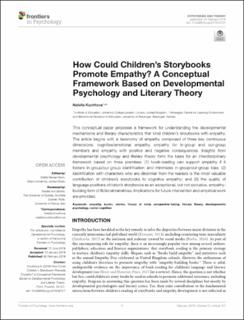| dc.contributor.author | Kucirkova, Natalia | |
| dc.date.accessioned | 2023-01-25T12:01:13Z | |
| dc.date.available | 2023-01-25T12:01:13Z | |
| dc.date.created | 2019-01-31T13:50:11Z | |
| dc.date.issued | 2019 | |
| dc.identifier.citation | Kucirkova, N. (2019). How could children’s storybooks promote empathy? A conceptual framework based on developmental psychology and literary theory. Frontiers in psychology, 10, 121. | en_US |
| dc.identifier.issn | 1664-1078 | |
| dc.identifier.uri | https://hdl.handle.net/11250/3046275 | |
| dc.description.abstract | This conceptual paper proposes a framework for understanding the developmental mechanisms and literary characteristics that bind children’s storybooks with empathy. The article begins with a taxonomy of empathy composed of three key continuous dimensions: cognitive/emotional empathy, empathy for in-group and out-group members and empathy with positive and negative consequences. Insights from developmental psychology and literary theory form the basis for an interdisciplinary framework based on three premises: (1) book-reading can support empathy if it fosters in-group/out-group identification and minimizes in-group/out-group bias; (2) identification with characters who are dissimilar from the readers is the most valuable contribution of children’s storybooks to cognitive empathy; and (3) the quality of language positions children’s storybooks as an exceptional, but not exclusive, empathy-building form of fictional narratives. Implications for future intervention and empirical work are provided. | en_US |
| dc.language.iso | eng | en_US |
| dc.publisher | Frontiers Media S.A. | en_US |
| dc.rights | Navngivelse 4.0 Internasjonal | * |
| dc.rights.uri | http://creativecommons.org/licenses/by/4.0/deed.no | * |
| dc.title | How could children’s storybooks promote empathy? A conceptual framework based on developmental psychology and literary theory | en_US |
| dc.type | Peer reviewed | en_US |
| dc.type | Journal article | en_US |
| dc.description.version | publishedVersion | en_US |
| dc.rights.holder | The author | en_US |
| dc.subject.nsi | VDP::Samfunnsvitenskap: 200 | en_US |
| dc.source.pagenumber | 15 | en_US |
| dc.source.volume | 10 | en_US |
| dc.source.journal | Frontiers in Psychology | en_US |
| dc.identifier.doi | 10.3389/fpsyg.2019.00121 | |
| dc.identifier.cristin | 1670490 | |
| dc.relation.project | Norges forskningsråd: 275576 | en_US |
| cristin.ispublished | true | |
| cristin.fulltext | original | |
| cristin.qualitycode | 2 | |

